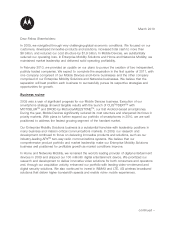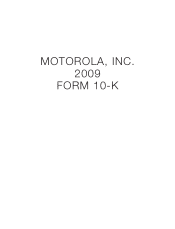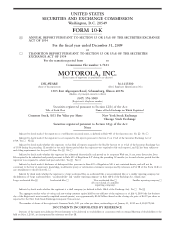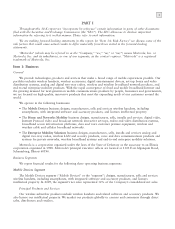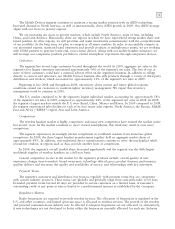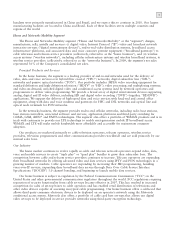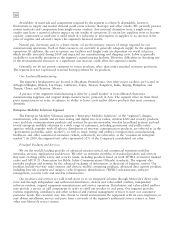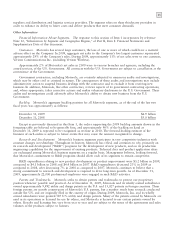Motorola 2009 Annual Report Download - page 13
Download and view the complete annual report
Please find page 13 of the 2009 Motorola annual report below. You can navigate through the pages in the report by either clicking on the pages listed below, or by using the keyword search tool below to find specific information within the annual report.
5
handsets were primarily manufactured in China and Brazil, and we expect this to continue in 2010. Our largest
manufacturing facilities are located in China and Brazil. Each of these facilities serves multiple countries and
regions of the world.
Home and Networks Mobility Segment
The Home and Networks Mobility segment (‘‘Home and Networks Mobility’’ or the ‘‘segment’’) designs,
manufactures, sells, installs and services: (i) digital video, Internet Protocol (‘‘IP’’) video and broadcast network
interactive set-tops (‘‘digital entertainment devices’’), end-to-end video distribution systems, broadband access
infrastructure platforms, and associated data and voice customer premise equipment (‘‘broadband gateways’’) to
cable television and telecom service providers (collectively, referred to as the ‘‘home business’’), and (ii) wireless
access systems (‘‘wireless networks’’), including cellular infrastructure systems and wireless broadband systems, to
wireless service providers (collectively, referred to as the ‘‘networks business’’). In 2009, the segment’s net sales
represented 36% of the Company’s consolidated net sales.
Principal Products and Services
In the home business, the segment is a leading provider of end-to-end networks used for the delivery of
video, data and voice services over hybrid fiber coaxial (‘‘HFC’’) networks, digital subscriber line (‘‘DSL’’)
networks and passive optical networks (‘‘PON’’). Our portfolio includes: MPEG video encoding equipment for
standard-definition and high-definition television (‘‘HDTV’’ or ‘‘HD’’); video processing and multiplexing systems;
and video-on-demand, switched digital video and conditional access systems used by network operators and
programmers to deliver video programming. We provide a broad array of digital entertainment devices supporting
analog, digital and IP video delivery, including HD and digital video recording (‘‘DVR’’) (together, ‘‘HD/DVR’’)
applications. We support the delivery of high-speed data and voice services with head-end and central office
equipment, along with data and voice modems and gateways for HFC and DSL networks and optical line and
optical node terminals for PON networks.
In the networks business, the segment provides end-to-end cellular networks, including radio base stations,
base station controllers, associated software and services, application platforms and third-party switching for
CDMA, GSM, iDEN and UMTS technologies. The segment also offers a portfolio of WiMAX products and is in
trials with customers to provide our LTE technology to enable next-generation mobile IP broadband access.
WiMAX and LTE will make mobile bandwidth more affordable and accessible for mainstream consumer
adoption.
Our products are marketed primarily to cable television operators, telecom operators, wireless service
providers, television programmers and other communications providers worldwide and are sold primarily by our
internal sales force.
Our Industry
The home market continues to evolve rapidly as cable and telecom network operators expand video, data,
voice and mobile services to create ‘‘triple play’’ or ‘‘quad play’’ bundles to grow their subscriber base. The
competition between cable and telecom service providers continues to increase. Telecom operators are expanding
their broadband networks by offering advanced video and data services using IPTV and PON technologies in a
growing number of markets. Cable operators are responding by increasing their HD programming, bundling
voice-over-IP services, expanding their broadband data service through Data Over Cable Service Interface
Specifications (‘‘DOCSIS’’) 3.0 channel bonding, and beginning to launch mobile data services.
Our home business is subject to regulation by the Federal Communications Commission (‘‘FCC’’) in the
United States and other governmental communication regulators throughout the world. FCC regulations requiring
separation of security functionality from cable set-tops became effective in 2007. This has resulted in increased
competition for sales of set-top boxes to cable operators and has enabled retail distribution of televisions and
other video devices capable of accessing encrypted cable programming. Our home business offers a cablecard that
allows third-party consumer electronic devices to be deployed on an operator’s network using the Motorola
conditional access system. Motorola also offers a portfolio of cable card host set-tops that allows our digital
video set-tops to be deployed in service provider networks using third-party encryption technology.


